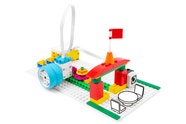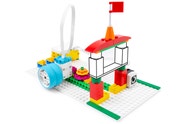SPIKE™ Essential
Snack Stand
Oh, no! Daniel dropped his snack. Help him get a new one from the snack stand.
30-45 min.
Beginner
Grades 1-2

Prepare
- Review the Snack Stand lesson in the LEGO® Education SPIKE™ App.
- If necessary, pre-teach these related vocabulary words: effective, serve, and tool.
- Consider the abilities and backgrounds of all your students. Differentiate the lesson to make it accessible to everyone. See the Differentiation section below for suggestions.
- If time allows, plan and facilitate the math extension. See the Extension section below for more information.
Engage
(Whole Class, 5 Minutes)
- Facilitate a quick discussion about the importance of testing to make sure an object works as it should.
- Talk with your students about objects that need to work properly when they're eating.
- Ask questions, like: How could you test to make sure a table is flat so that your food won’t roll off? If the table isn’t flat, what could you do to fix it?
- Introduce your students to the story’s main characters and the first challenge: serving another snack to Daniel.
- Distribute a brick set and a device to each group.
Explore
(Small Groups, 30 Minutes)
- Have your students use the LEGO® Education SPIKE™ App to guide them through their first challenge:
- Create and test the program that serves another snack to Daniel when he shows his blue ticket to the Color Sensor.
- Have your students iterate and test their models to complete the next two challenges in the app:
- Change the program to improve the snack stand.
- Upgrade the snack stand for Daniel. Make sure he can still reach his snack.
- You can find coding and building support in the Tips section below.
Explain
(Whole Class, 5 Minutes)
- Gather your students together to reflect on their completed challenges.
- Ask questions, like: What did you do to upgrade the snack stand? How did you make sure that Daniel could still get his snack from the upgraded snack stand?
Elaborate
(Whole Class, 5 Minutes)
- Prompt your students to discuss and reflect on the importance of testing a prototype to ensure that it works as intended.
- Ask questions, like: Why is it important to test and make sure your prototype works as you want it to? What happens when your upgraded prototype fails and doesn’t work as you wanted?
- Have your students clean up their workstations.
Evaluate
(Ongoing Throughout the Lesson)
- Ask guiding questions to encourage your students to “think aloud” and explain their thought processes and reasoning in the decisions they've made while building and programming.
Observation Checklist
- Measure your students’ proficiency in testing an upgraded prototype to ensure that it works as intended.
- Create a scale that matches your needs. For example:
- Needs additional support
- Can work independently
- Can teach others
Self-Assessment
- Have each student choose the brick that they feel best represents their performance.
- Yellow: I think I can test an upgraded prototype to make sure it does what I want it to.
- Blue: I can test an upgraded prototype to make sure it does what I want it to.
- Green: I can test an upgraded prototype to make sure it does what I want it to, and I can help a friend do it too.
Peer-Feedback
- In their small groups, have your students discuss their experiences working together.
- Encourage them to use statements like these:
- I liked it when you…
- I'd like to hear more about how you…
Tips
Coding Tip
- After your students complete their first challenge, they'll be provided with three Inspiration Coding Blocks to help them modify their programs.
- The Inspiration Coding Blocks are intended to spark their imaginations as they experiment to find their own solutions.




Model Tip
- After your students complete their second challenge, they’ll be provided with three Inspiration Images and an open-ended prompt for improving their models.
- The Inspiration Images are to help spark their imaginations as they experiment and change their models.




There aren't any building instructions for this challenge.
Differentiation
Simplify this lesson by:
- Shortening the lesson to only include the first challenge
- Selecting one Inspiration Image to help your students change their models
Increase the difficulty by:
- Adding other colors for the Color Sensor to react to
- Adding more items to the menu for Daniel to order and eat
Extension
- Have your students use the collected data from the snack stand to create a bar graph on paper or using different manipulatives. Guide your students in a discussion about which color was used the most, least, etc.
If facilitated, this will extend beyond the 45-minute lesson.
Math: CCSS.MATH.CONTENT.2.MD.D.10
Teacher Support
Students will:
- Practice testing prototypes to ensure that they meet a need
- Modify and remix a solution
- Practice helping a story character
- Describe key ideas or details from a text
(one for every two students)
- LEGO® Education SPIKE™ Essential Set
- Device with the LEGO® Education SPIKE™ App installed
- CSTA 1A-AP-11
- NGSS K-2 ETS 1-3
- ISTE 1.4c
- CCSS.ELA-LITERACY.SL.2.2
Math Extension
- CCSS.MATH.CONTENT.2.MD.D.10